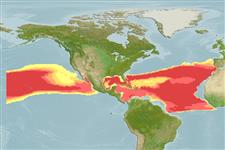分類 / Names
俗名 | 同種異名 | Catalog of Fishes(屬, 種) | ITIS | CoL | WoRMS | Cloffa
Teleostei >
Lophiiformes (Anglerfishes)
鮟鱇目 (Anglerfishes) >
Thaumatichthyidae (Wolftrap anglers (Ref. 7463), Wolftrap Seadevils (Ref. 86949))
奇鮟鱇科 (Wolftrap anglers (Ref. 7463), Wolftrap Seadevils (Ref. 86949))
Etymology: Lasiognathus: Greek, 'lasios' = hairy or wooly + Greek, 'gnathos' = jaw (with reference to the huge number of long teeth of the upper jaw) ( Ref. 86949).
More on author: Regan.
Environment: milieu / climate zone / depth range / distribution range
生態學
海洋 深海區的; 深度上下限 0 - 4000 m (Ref. 27827). 深水域
Eastern Central Pacific. Atlantic Ocean: in tropical waters.
中太平洋東部。 大西洋: 在熱帶水域中。
大小 / 重量 / 年齡
Maturity: Lm ? range ? - ? cm
Max length : 7.7 cm SL (female)
簡短描述
檢索表 | 型態特徵 | 形態測量圖
背的軟條 (總數) : 6 - 7; 臀鰭軟條: 4 - 5. Escal bulb without membranous anterior crest. Distal escal appendage an elongate, cylindrical stalk, with a slender, elongate prolongation emerging anteriorly from bases of escal hooks, bearing numerous lateral serrations or filaments. Posterior escal appendage laterally compressed and rounded (Ref 27827). Length of illicium 39-46%; posterior escal appendage a compressed flange, length 1.4-4.4% SL, with irregularly rounded edge and broad base, emerging from below escal pore; escal hooks black, relative length of medial (largest) hook decreasing with age from about 10.3% SL in 30mm specimen to 3.6% SL in 77mm specimens (Ref. 86949).
沒有膜狀的前面冠的餌球。 末梢部的餌球附肢一個延長, 圓筒形的悄悄靠近, 具有一個前面地從餌球鉤的基底出現的細長又細長的延伸, 生長著很多的側面鋸齒或絲狀突起。 在後部的餌球附肢側扁的而且圓的 (參考文獻 27827).
Feeds mainly on fish and occasionally on invertebrates (Ref. 27828).
主要吃魚與偶然吃無脊椎動物.(參考文獻 27828)
Life cycle and mating behavior
成熟度 | 繁殖 | 產卵場 | 卵 | 孕卵數 | 仔魚
中太平洋東部。 大西洋: 在熱帶水域中。
Bertelsen, E. and T.W. Pietsch, 1996. Revision of the ceratioid anglerfish genus Lasiognathus (Lophiiformes: Thaumatichthyidae), with the description of a new species. Copeia 1996(2):401-409. (Ref. 27827)
IUCN 瀕危狀態 (Ref. 130435: Version 2024-2)
無危 (LC) ; Date assessed: 14 July 2014
人類使用
工具
特別的報告
下載 XML
網路資源
Estimates based on models
Preferred temperature (Ref.
123201): 3.1 - 7.6, mean 4.7 °C (based on 124 cells).
Phylogenetic diversity index (Ref.
82804): PD
50 = 0.5352 [Uniqueness, from 0.5 = low to 2.0 = high].
Bayesian length-weight: a=0.01995 (0.00906 - 0.04395), b=3.01 (2.83 - 3.19), in cm total length, based on all LWR estimates for this body shape (Ref.
93245).
營養階層 (Ref.
69278): 4.0 ±0.60 se; based on food items.
Fishing Vulnerability (Ref.
59153): Low vulnerability (10 of 100).
